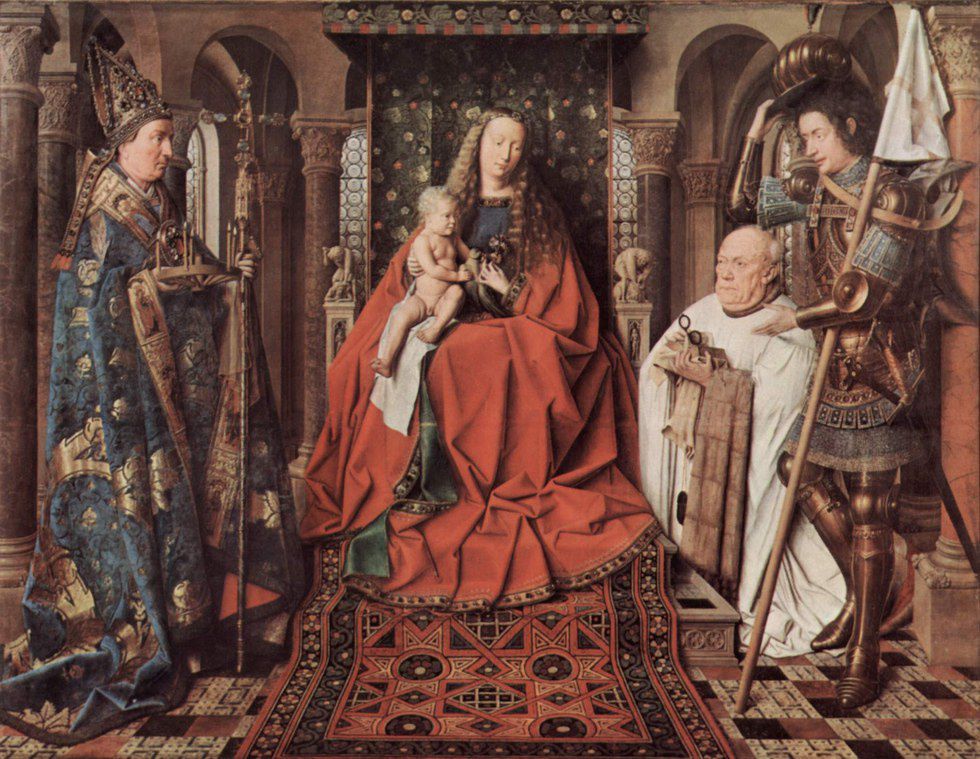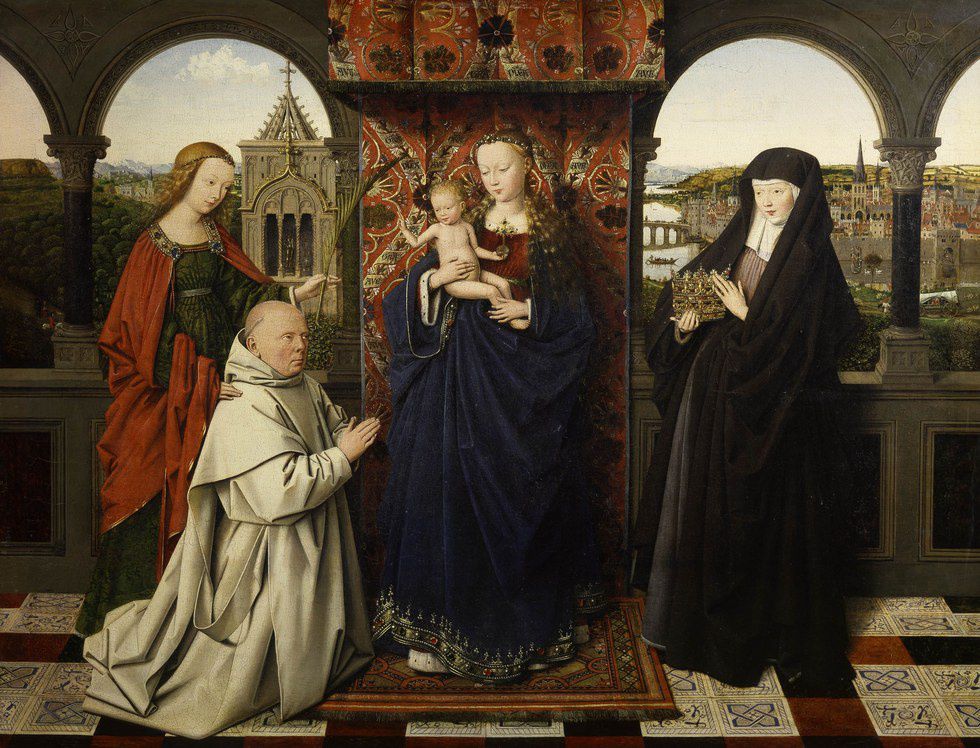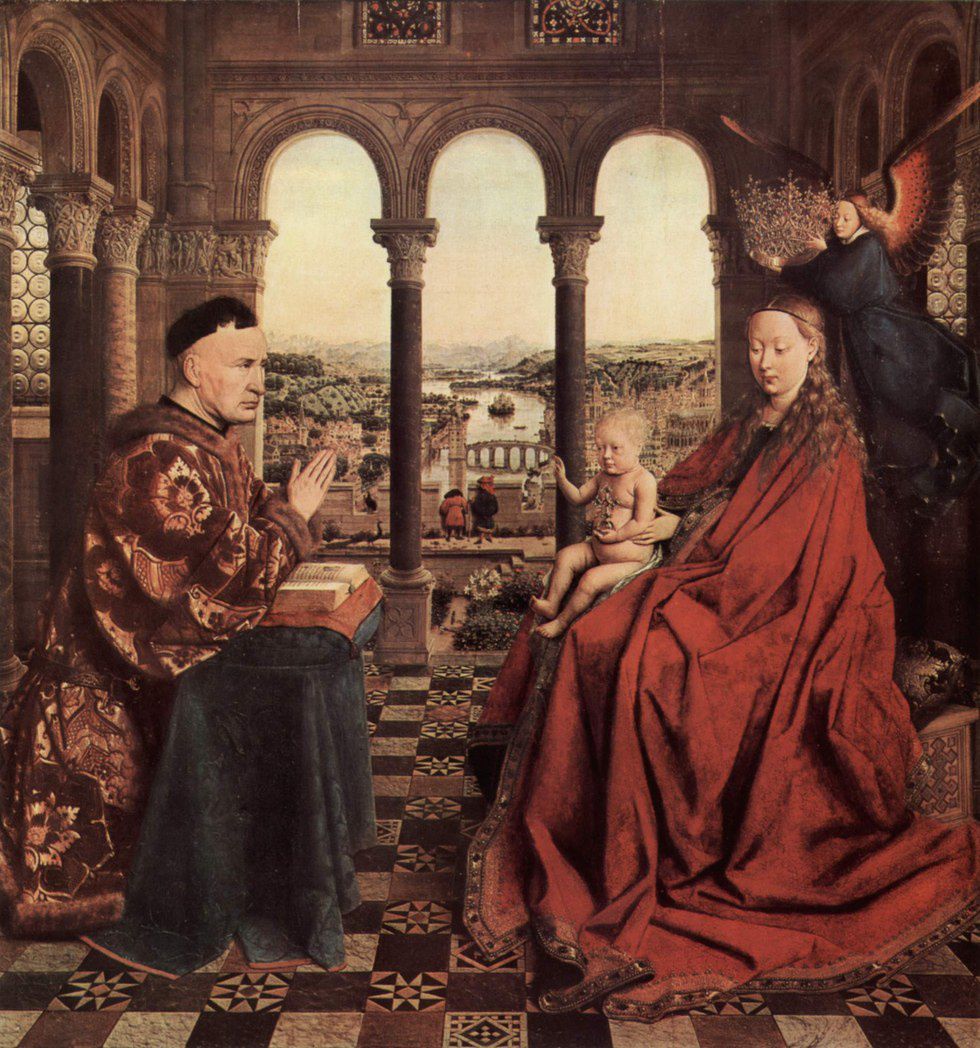“Iconography, good iconography, strives to convey invisible reality in a visible form.” - Peter Pearson
When analyzing a painting, every brushstroke assisted in creating a more intricate and detailed image of the artist’s vision. Sometimes an artist’s vision can duplicate and be found within many other paintings, which is how themes develop. Themes found within paintings, not only link the artist to their work, but further link the artist to a personal view and conviction. Jan van Eyck, while he is one of the most famous artist in our current history, he is also guilty of providing theme work within his artworks. In order to better acquaint the current viewpoint of van Eyck with his actual beliefs, is through an analysis of his artworks and a comparison on common themes.
Jan van Eyck produced many paintings with the Virgin Mary as a part of the subject matter; however, three paintings stand out that provide the Virgin Mary as the main focus of the artwork. These three paintings, The Madonna with Canon Van der Paele, Virgin Child, with Saints and Donors, and The Virgin and Child with Chancellor Rolin. Through an iconographical analysis of Jan van Eyck’s paintings of the Virgin Mary, a symbolic Christian theme of salvation and resurrection will be discovered and a deeper understanding of specific attributes throughout the paintings will be discovered.
The Madonna with Canon Van der Paele
Jan van Eyck was born around 1395 in Maaseik, but documentation of van Eyck is not prevalent until 1422. After this period of documentation, van Eyck was known as a court painter and assisted many courtly officials on diplomatic missions and religious miniatures. As a prominent court painter, van Eyck had a relatively small catalogue. One of his most famous paintings, and also one of his largest, is The Madonna with Canon Van der Paele, which was produced roughly between 1434 and 1436.
The painting of The Madonna with Canon Van der Paele includes five key figures: the Virgin Mary, Baby Jesus, Saint Donatian of Reims, Saint George, and the patron of the painting, Canon Van der Paele. Kneeling next to Mary and the Baby Jesus, is Canon Van der Paele dressed in white while holding his bible and glasses. Next to the Canon is Saint George, who is still dressed in a harness and riding attire, while holding a large white flag. Saint George removes his helmet and address both Mary and the Baby Jesus by gesturing with his hand. Directly across from the Canon and Saint George, the bishop Saint Donatian of Reims is standing to the right of Mary. He is dressed in liturgical robes, and is holding both a crosier and a wheel equipped with five burning candles. Directly in the middle of the painting is where the Virgin Mary and Baby Jesus are positioned. The Virgin Mary is seated on lavishly decorated throne and dressed in a red cloak. The Baby Jesus is sitting on her lap while playing with both a bouquet of flowers and a parakeet. The room the painting is stationed in contains rounded arches supported by ornate pillars, which imply an apse or other rounded structure. Along with the rounded arches, the heavily decorated tile flooring and stained glass windows would imply that this is an important place. As stated by Irwin Panofsky, Jan van Eyck’s paintings are full of rich imagery and underlying messages. These details are found throughout many of his paintings, and The Madonna with Canon Van der Paele is no exception.
The first and most noticeable detail of this painting is the people represented. In earlier religious paintings, the saints were depicted separate from the Virgin Mary; however, in van Eyck’s painting, it is one of the first paintings known to incorporate all figures on the same panel. This is a symbolizes the worship of Virgin Mary as a key religious figure. The depiction of Mary among several saints is often referred to as a “holy conversation,” translated to sacra conversazione.
The presence of both saints make this meeting appear that it is between Mary and the Canon, but the two saints are present in order to maintain order and stand in as mediators. While Saint George is the Canon’s patron saint, Saint Donatian also plays a large factor in the life of the Canon due to the St. Donaas church being dedicated to him and housing many of his relics. This relationship between the saint and the St. Donatian’s Cathedral are also present in Saint Donatian’s robes. The cope and mitre that are present on the saint are reminiscent, if not identical, to those in the cathedral’s inventories. Along with the garments of Saint Donatian, the crosier in his hand is also similar to one that was kept at the church. The original crosier that was house at St. Donaas church was said to contain a splinter of the original Cross, making it highly symbolic to the Christian faith.
Saint George is represented in his traditional full armor and carrying his flag of white with a red cross. This image of Saint George comes from the story of his life, because he is associated with being a Greek soldier who died defending his Christian faith. He is also associated with the story of the saint who killed a dragon in order to save an entire village from, not only the dragon, but their lack of Christian faith.
The colors represented in the painting are specifically unique to the city of Bruges, because red, blue, white, and gold are all represented in the painting. These four colors are the heraldic colors of the city and can be found on each of our main figures: Mary wearing red, Saint Donatian wearing blue, the Canon and Saint George wearing white and gold.
On either side of the throne that Mary sits, two images can be found: Adam and Eve. These two figures are linked to the original sin and the fall of humankind; however, their sin was not redeemed until Jesus was sacrificed on the cross. Interestingly enough, outside of the reference to the original sin, the crosier held by Saint Donatian represents a piece of the cross in which Jesus was sacrificed upon. These two images bring the Christian faith in full circle, but representing both the problem and the resolution.
This is not the only place where the theme of death is present, but above the sculpture of Eve is a sculpture of Samson and the lion. This symbol is a traditional figure in the Christian faith, because it represents the defeat of death and the role of Jesus Christ as the Christian’s savior. Above the sculpture of Adam, Cain’s murder of Abel can be found. These four sculptures represent a large amount of Christian salvation ideologies, such as the fall from grace, resurrection, and sacrifices. The representation on the left side of Mary, Samson and the Lion, highlight the descent in which Jesus saves the good souls and escorts them to heaven. This theme is also found within other depictions found in the painting, such as the Liberation of Loth and David and Goliath, as well as, Abraham’s Blessing of the Oriental kings.
As a whole, the deeper meanings found within symbolic images and figures present in van Eyck’s painting of Virgin and Child with Canon Joris van der Paele, all seem to revolve around the idea of salvation. Including the saints in the image, even one standing directly beside the Canon, and by commissioning this painting himself, the Canon may have directed the creation of this painting in order to secure his own salvation and a place in heaven.
Virgin Child, with Saints and Donors
Another painting created by Jan van Eyck is the Virgin Child, with Saints and Donors. Found within this painting, the Virgin Mary can be found in the center of the painting holding Baby Jesus. The Virgin stands on a beautifully ornate oriental carpet and is framed by two arched windows. Surrounding the Virgin are three other figures: Saint Barbara, Saint Elizabeth of Hungary, and a Carthusian monk.
Both saints found in this painting have a representational attribute to help identify them. Found behind St. Barbara is the three-windowed tower that is associated with her. Within one of the three windows of the tower is a sculpture of Mars, the God of war, which is fitting for St. Barbara since she is the patron saint of soldiers. Saint Elizabeth of Hungary is clothed in her religious habit as opposed to the crown, similar to the one in her hands, she adorned prior to giving her life to ministry and prayer.
The Carthusian monk present is identified as Jan Vos, who was prior of the Charterhouse of Genadedal. As a very prominent figure in the life of monasteries during the fifteenth century, many important roles were held prior to becoming appointed to Genadedal. According to documents relating to the painting, it is believed the painting was ordered as “a pious memorial of Dom Jan Vos, Prior of the Monastery.”
The image of the monk is kneeled at the feet of Mary in a position of prayer, while St. Barbara’s right hand rest upon his shoulder. The position St. Barbara is in makes her appear as a sponsor figure for the monk and is holding a palm branch towards Baby Jesus and Mary. The palm branch is representational of peace and eternal life, so it is possible to assume that St. Barbara is a sponsor for the monk who is asking for eternal peace from Baby Jesus and the Virgin Mary. In return, Baby Jesus has raised his hand in a gesture of blessing to the monk.
St. Elizabeth’s connection may be through the connection of a rich family who made wealthy donations to the Carthusian monasteries; and the landscape found behind her figure is that of a heavily ornate city with tall cathedral towers and a wall surrounding the entire city. The connection between the other side of the river and the protected city of worship is the bridge which vanishes into the direction of Mary. The bridge, linking Mary and Jesus to the enclosed city of cathedrals represents the idea behind Christ being the salvation for mankind. The Baby Jesus is holding a cross in his hands, which represent his impending sacrifice to save all sinners.
The Virgin of Chancellor Rolin
The third painting by Jan van Eyck to be analyzed for this research is that of The Virgin and Child with Chancellor Rolin. Similar to the two other paintings, rounded arches are extremely prominent in the architectural build of the room. This painting does not play the Virgin in the middle of the painting; however, instead she is on the right hand side of the painting and Chancellor Rolin is directly across from her on the left. Floating about the Virgin Mary, who is holding Baby Jesus in her lap, is an angel with large wings holding a massive crown above the Virgin’s head. Baby Jesus is holding an ornate cross in his left hand, with his right hand raised slightly in the air. Chancellor Rolin is seating in a mirroring position to the Virgin Mary with his hands raised in prayer and a book laying opened on a pillow placed on his lap. Throughout the windows a garden can be seen, along with a rolling landscape, a river and boat, two more figures in the distance, a town skyline, and animals. Although the background of the painting provides many features, the foreground is where the focus of this painting lies.
The Virgin is placed on a delicate marble seat and wearing a relatively simple red cloak. The Virgin’s cloak is a solid fabric until the very edge, where it is laced with pearls and other precious gemstones. The posture held by the Virgin is very reminiscent of traditional appearance of the Virgin and her infinite wisdom. The Virgin Mary is not looking at the Chancellor, but instead, her gaze appears to be focusing on the item in Baby Jesus’ hand. The item in his hand is a globe with a jeweled cross on top, which may symbolize his inevitable sacrifice on the cross in his future. The jeweled cross represents both earthly desires and power, and his spiritual conviction. Along with the symbolic nature of the cross, it appears that the child is sitting on a white cloth, in a reference to a funerary shroud that is also in his future. Baby Jesus is holding his right hand in the air, as a symbol of blessing to the Chancellor.
The Chancellor, unlike the previous two paintings discussed, is shown without saints and at the same level as the Virgin; and the book found on his lap is the Book of Hours. Although the Chancellor is praying from his devotional book and sitting in front of the Virgin and Christ, none of the three figures are fully acknowledging the other. The Chancellor’s gaze is slightly off, the Virgin is gazing towards the cross in Christ’s hand, and Christ is gazing in a downward motion.
The pillars of the arches provide many different sculptures that represent bible stories, such as, Noah and the Ark, Adam and Eve’s expulsion, and Cain and Abel. All three of these sculptures represent the original sin and mankind’s consequence. The pillars that are supporting the architectural structure of the building, are also supporting the never ending tale of mankind’s fall from grace.
The garden found in the background of the photo inhabits several different factors, such as the birds, the two figures, and the plants. As a traditional symbol of the Virgin, flowers have their individual representations. For instance, the white lilies are symbolic of the Virgin’s purity and daises are symbolic of her innocence. There are two different kinds of birds present in the garden scene: magpies and peacocks. The magpies usually allude to death and the peacocks allude to eternal life. Similar to other references of original sin, like the sculptures on the pillars, only being redeemed by the sacrifice of Christ, like the foreshadowing symbol of the cross in Christ’s hand, it is interesting that two birds together that symbolize both the alpha and omega.
The beautiful landscape beyond the focal point is immensely detailed for the time period, in fact, it was one of the first portrayals of a landscape within a framed edge of the arches. The depth the landscape creates brings the whole picture into a more realistic realm, and provides a very solid example of atmospheric perspective. The flowing river establishes a definite break between the Chancellor and Mary, and both landscapes behind each figure represents themselves. For instance, the landscape behind Mary is a more celestial world with churches and chapels surrounded by a wall, and the landscape behind the Chancellor is a city with houses, convent and a cloister. While the river does create two separate worlds, the is a connection between the two by boat and bridge. A cross is present on the bridge, which implies the sacrifice of Christ is what links the two worlds together, both sin and paradise.
Common Themes
All three paintings previously listed above are linked together through many different factors, but all have a common theme of death and salvation. Each painting discussed provides a single figure asking for eternal peace; two of the three paintings even have sponsors to help ensure their requests are heavily considered. Each main figure represented opposite of Mary and Baby Jesus are presenting themselves in a vulnerable way in order to request salvation.
Virgin Child, with Saints and Donors and The Virgin of Chancellor Rolin both contain a unique perspective found within the background. The left side of both paintings represent an earthly building or city structure, while the right side of the painting represents a walled city of cathedrals. The walled city represents the eternal life the figures are requesting, and the bridge connects two worlds together. In a sense, Mary is their way of receiving passage across the bridge; however, all three paintings include Christ in Mary’s lap. While it appears the three figures are requesting salvation from Mary, it is actually the symbolism of Christ that provides the salvation for each figure. The underlying message of Christ and the cross implies his sacrifice in order to save all of mankind, so it is fitting that each figure sits or kneels humbly before Christ.
The reoccurring symbol of earthly sin is also prominent in The Virgin of Chancellor Rolin and The Madonna with Canon Van der Paele with sculptural bible story scenes. Virgin Child, with Saints and Donors also provides a sense of damnation through the idea of imprisonment. Like St. Barbara being imprisoned in the tower, the other two paintings provide sculptural scenes of earthly figures being imprisoned by their own sins.
Found within all three paintings, a theme of original sin and eternal life connect the underlying message of each painting to one another. Through an iconographical analysis, all three paintings were able to be fully analyzed and deciphered to provide the underlying meaning behind each symbolic item. The items found link these three paintings together; but to continue the research and further expand upon the common theme of van Eyck, a wider analysis of his paintings need to be performed.























